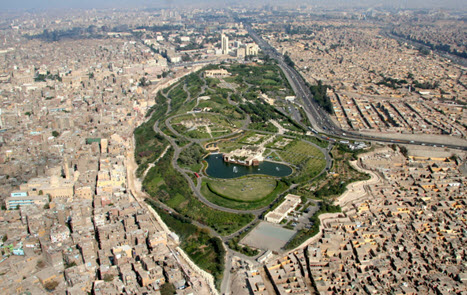On December 10, 1990, Mawlana Hazar Imam signed a Protocol of Agreement on behalf of the Aga Khan Trust for Culture with the Governor of Cairo, His Excellency Mahmoud Sheriff to create a public park in Cairo. Following the signing, Mawlana Hazar Imam, His Excellency Mahomoud Sheriff, and Her Excellency Madame Suzanne Mubarak participated in the foundation stone and tree planting ceremony.


Al-Azhar Park was inaugurated on March 25, 2005 by Her Excellency Madame Suzanne Mubarak in the presence of Mawlana Hazar Imam. After twenty years of planning and construction, the 500-year-old accumulation of debris has been transformed into a leisure and recreational space in Cairo, the former Fatimid capital.


Fatimids
Named after the Prophet’s daughter, the Fatimids, ancestors of Mawlana Hazar Imam, established their rule in 909 in Tunisia, in North Africa. During their reigns, Imams al-Mahdi and al-Mansur founded the cities of al-Mahdiyya and al-Mansuriyya, named after them. Traces of Fatimid grandeur can still be found in Mahdiyya, including the mosque commissioned by Imam al-Mahdi which continues to be used today after its restoration in the 1960s.
In 973, Imam Al-Mu’izz transferred the dynasty’s capital to a new city in Egypt that he designed. Originally named Mansuriyya after its prototype, it was re-named ‘al-Qahira al-Mu’izziyya’ (‘the Victorious One of al-Mu’izz’), al-Qahira for short, today known as Cairo. Al-Azhar mosque, founded by Imam Mu‘izz in 973 CE, was named in memory of the title al-Zahra (‘the luminous’), which is associated with Fatima, the daughter of the Prophet and the wife of the first Shi‘a Imam, Hazrat Ali, from whom the Fatimids claimed direct descent.
Cairo also became a major centre for the production of valuable artifacts; furniture and textiles made here had a particularly high reputation and were exported to the entire Mediterranean area. S. H. Nasr notes that “members of this same dynasty [Fatimids] became patrons of the arts and made possible one of the most creative periods of Islamic art” (Ismai’ili Contribution to Islamic Civilization p 2).
At its peak, the Fatimid Empire extended from the Atlantic shores of North Africa, across the southern Mediterranean and down both sides of the Red Sea, including Mecca and Medina. The reign of the Fatimids for almost two centuries, is often referred to as a ‘golden age’ in Ismaili history, but also “one of the greatest eras in Egyptian and Islamic histories, and as such, a milestone in the development of Islamic civilisation” (Daftary, A Short History of the Ismailis, p 66).
Sources:
Azim Nanji, The Ismailis in History, The Institute of Ismaili Studies
Farhad Daftary, A Short History of the Ismailis, Edinburgh University Press, 1998
Heinz Halm, The Fatimids and their Traditions of Learning, I.B. Tauris in association with The Institute of Ismaili Studies, London, 1997
